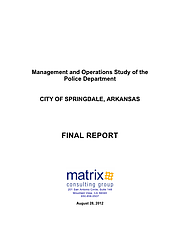SPRINGDALE — City residents could see more police officers on the street if Springdale follows the recommendations of an efficiency study of the Police Department.
The problem, said Mayor Doug Sprouse, is finding the money to carry through on the advice of the Matrix Consulting Group.
The company recommended raising police salary averages to match surrounding cities and the level of Springdale firefighters. It also called for adding sergeants, jailers and dispatchers.
Sprouse recommended a 6 percent raise for uniformed employees — both police and fire — be included in the 2013 budget, he said, but other changes may have to wait.
“We’ll do as much as we can when we can,” Sprouse said. “We’ll have to look at our revenues when we decided what we need to add.”
Raises for Police Department employees would cost the city about $389,000, said Laura Favorite, city finance director. The increase would include civilian employees.
Next year’s budget has not yet been approved by the City Council. The council usually works on the budget in October and November and approves it in December.
Salaries are paid from the general fund, which is partially funded by 0.5 percent of the city’s sales tax revenue.
Springdale’s sales tax revenue fell for three years before leveling off and starting to recover in the last year, according to city records. The city levies a 2 percent sales tax. The remaining 1.5 percent goes to repay bonds.
The study showed Springdale’s police pay scale, from entry level to the highest pay for sergeants, runs lower than that in Rogers, Bentonville and Fayetteville. Salaries are 2 percent to 23 percent lower, according to the report.
The study also stated that salary ranges in the Springdale Fire Department, when compared to ranges for similar positions in the Police Department, are higher. The differences varied from 10 percent to 18 percent higher.
At a Glance
Pay Scales For The Four Largest Northwest Arkansas Police Departments
Springdale’s rate is compared to an average of the three other cities.
Springdale Rogers Bentonville Fayetteville Average
Officer - Entry $30,090 $31,179 $32,261 $34,857 -9 percent
Officer - High $43,280 $37,170 $47,778 $47,267 -2 percent
Sergeant - Low $37,025 $48,173 $42,910 $45,399 -23 percent
Sergeant - High $55,538 $59,114 $63,565 $61,476 -11 percent
Rogers, Bentonville and Fayetteville have positions between officer and sergeant with higher pay.
Source: Matrix Consulting Group study of the Springdale Police Department
At a Glance
Springdale Police Department Employees
Division Sworn Civilian
Chief’s Office 1 1
Administration 11 24
Service 4 18
Patrol 84 3
Criminal Investigations 25 2
Total 125 48
Source: Matrix Consulting Group Study Of The Springdale Police Department
More Employees
The study also recommended the addition of manpower for the Police Department.
The recommendation is to add sergeants to the patrol division, two to three jailers and three dispatchers.
The sergeants are needed for supervision, Chief Kathy O’Kelley said. A captain oversees the patrol division, with a lieutenant and two sergeants assigned as supervisors to each of the three daily shifts.
Sometimes only two supervisors are on duty per eight-hour shift. Vacations and sick days can reduce that to one, occasionally, O’Kelley said.
“I came by one night and we only had a lieutenant overseeing 12 patrol officers,” O’Kelley said. “I decided we had to have two supervisors each shift, even if we had to pay overtime.”
Adding a sergeant to each patrol shift would solve that problem, she said.
Additional manpower can help in other ways, said Joe Perkins, a member of the national Fraternal Order of Police executive board.
Perkins, who lives in Owasso, Okla., retired from the Tulsa Police Department as a division commander. He said additional manpower would give officers more time to prevent crime instead of responding to it, he said.
“A study can help a department be proactive instead of reactive,” Perkins said. “If you are constantly answering calls, you don’t have time to run down the root cause of those calls, such as a burglary ring.”
Adding positions would also allow the department to perform more investigations and not have its manpower resources stretched so thin, O’Kelley said.
The national average is 2.3 officers per 1,000 in population, according to the FBI website. Springdale’s average of 1.8 officers per 1,000 puts it behind the national average, but on the same level as towns in their region from 100,000 to 50,000 in population, according to the website.
Jail, Dispatch Needs
Springdale has the last city jail in Washington County, O’Kelley said. Only those arrested for misdemeanors are held in the jail, with felony arrests going to the Benton or Washington county jails, depending on where the incident took place. Springdale’s city limits cross the county line.
Juveniles who are arrested go to county juvenile detention centers, with all adult women prisoners held more than a couple of hours going to county jails.
The city jail has bunks for 12 prisoners and a drunk tank that can hold up to 25. The department has nine jailers, three assigned to each shift. Some shifts have only two jailers, the minimum for the facility. When vacation of sickness cause a jailer to miss a shift, a patrol officer is called in to fill the jailer position, O’Kelley said.
An additional jailer on each shift would alleviate some of the manpower problems and keep patrol officers in the field, she said.
The biggest problem in the dispatch center is retaining employees, according to the report. The turnover rate for the 22 dispatcher positions has averaged 30 percent a year for the last three years.
“I would say the biggest reason for leaving is stress,” said Teresa Hudson, senior dispatcher.
Off-duty dispatchers are often called in to cover open shifts, Hudson said. Extra hours and constant training leaves dispatchers overworked, she said.
Additional dispatchers could cut the turnover rate which would also lower the number of people being trained, O’Kelley said.
The study recommended taking steps to retain officers, jailers and dispatchers, scheduling regular meetings to review the procedures of the department and ending funeral escorts.
“The study gives us good information when we go to the council and ask for money,” Sprouse said. “I think we also need give justification to our residents when we ask to spend their tax money.”
Winfred Phillips, the retired director of the Arkansas State Police and a Springdale resident, said a study can introduce new practices to organizations.
“You don’t want to become stale,” Phillips said. “You need to keep up with changes. If you have information about what other organizations are doing, you can take that to a council or a state Legislature when you ask for funding.”
Web Watch
Police Department
Efficiency Study
nwaonline.com


